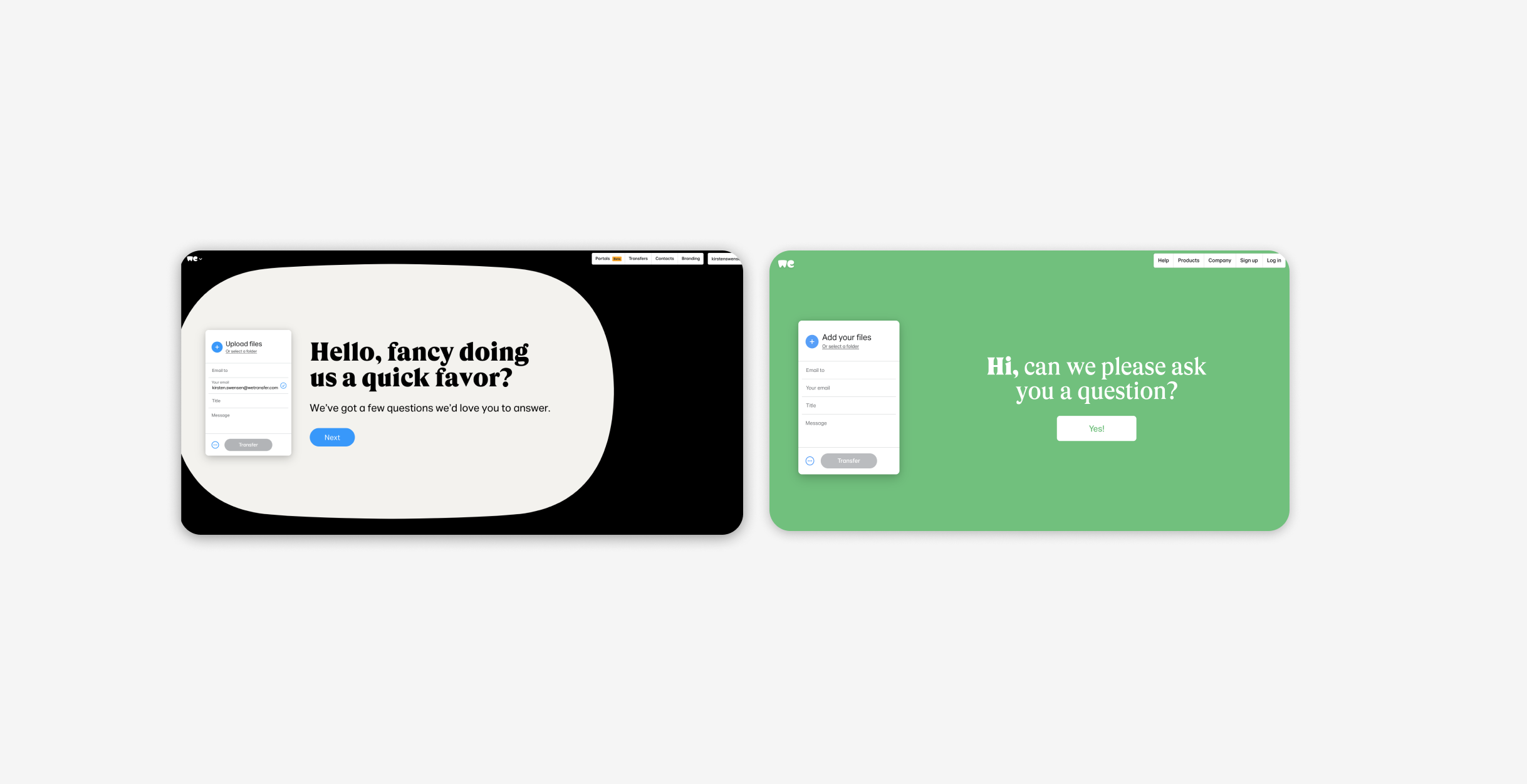Setting up client design systems, guidelines, templates and research for better collaboration.
Role: Senior Design Lead
Activities: Process Improvements, Cross-functional Leadership.
As the company and client base were rapidly growing it was crucial to become more systematic in our approach. I helped WeTransfer to standardise their processes, as well as develop client design systems and specs guidelines to ensure a smooth collaboration between designers, developers and sales resulting in increased revenue and efficiency and the ability to expand across markets more easily.
For this project I was the bridge between cross-functional teams between Ad-tech, Sales, Engineering and the Design Studio.
Main responsibilities were;
Stakeholder Management (Sales, Ad-tech, Engineering, Design, Marketing)
Stakeholder Management with Clients (Adobe in this case/example)
Crafting decks & presentations for our clients (Adobe in this case/example)
Leading a small team of developers for creation of code templates
Leading a small team of designers for creation of design systems
Supporting with design efforts
Setting up & improving A/B testing processes internally working closely together with Ad-tech Department
+175%
Increase in investment by key account
30%
Reduced project turnaround time by optimisation of templates, tiers and workflows
Problem
Clients can often come in last minute, delivering sloppy briefs under a tight timeline. Even though we had our quality standards and guidelines, we still wanted to be flexible and service oriented. Because the demand was higher than our capacity there was a need to adopt a more consistent and systematic approach.
Challenge
We wanted to serve more clients at the same time, especially our key clients because they valued our service and often spend 500K + budgets on campaigns but it was a challenge to keep up with the high demand. There was a need for consistency and efficiency to get more work done in time and improve collaboration and communication with clients.
Solution
After reviewing which accounts required the highest service needs we decided to create design systems and format guidelines to improve collaboration and increase efficiency between designers, developers, sales and clients through standardisation of low tier formats.
Key deliverables:
Client Design Systems
Asset & Format Guidelines
Fixed Coding Templates
A/B Testing to optimise metrics
Surveys
Design systems for each key account designers could re-use.
Mini design systems in figma ☑️
To improve efficiency I supported in the creation of design systems for some of the key accounts with the goal of creating more consistency in the overall campaigns so designers and developers could easily step in and use the design systems making it much easier to speed up production and work in a more systematic, concise and efficient way.
Standardised and fixed coding templates developers could re-use.
Fixed coding templates & QA Checklist ☑️
Next to the creation of these design systems, I also sat with a developer to brainstorm and create fixed responsive coding templates for the more common, low tier formats and we found a way to standardize them in github. This way developers could use existing fixed coding templates with the same code that were consistent to the design systems and responsive sizes. (instead of redo things like button sizes, headings and paddings manually.)
Specs & format best practises for better collaboration and external communication with key clients.
To improve client communication I created guidelines around documentation and specs for the available type of formats and assets we needed in the form of a checklist combined with a clear visual so this would create clarity for the client on what type of assets we needed and was easy to share with their internal stakeholders. This made it much easier to advise clients in sending us the right assets and specs to make our formats work.
Testing our hypotheses to optimise wallpapers and setting up surveys to measure behavioural and attitudinal metrics.
A/B Testing & Surveys 🔍
To offer more value to clients we proposed A/B tests and 5 second tests with the goal of optimising the CTR of the wallpapers. This ranged from copy, images, video’s, short vs. long form content, and positioning in CTA and logo’s. Next to A/B testing we send out survey’s to gain better understanding of how our advertisements were received and their attitude towards the brands.
Desired Outcome ☑️
A set of deliverables and best practises that enhance our processes and bring in data that outlines what works well and what doesn't on the advertising platform. (Not based on opinion but on data evidence and validated hypothesis by conducting qualitative and quantitative research.)
Impact & results
This team effort resulted in increased efficiency and a smoother collaboration between designers, developers, sales and key clients making it easier to expand across markets. This in turn contributed to a major growth in YoY revenue and an +175% increase in investment by the client in one of the accounts.
Next steps were to expand this into a product feature in the form of editable templates for the more straightforward formats, enhance self-service and enable clients to upload images/copy/video and decide on customisation so we could use our in-house time more efficiently and focus on bigger campaign ideas.











